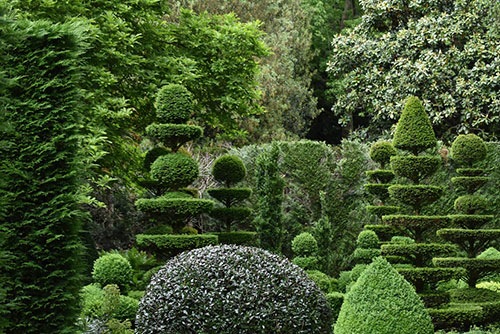
Pruning Trees and Shrubs
Poorly pruned trees and shrubs can develop into significant problems as they grow. Knowing how to correctly prune your trees and shrubs can keep them healthy and growing the way they were intended.
nannenarboretum.org gathered information on how to prune trees and shrubs, the benefits, and common mistakes.
How To Prune Trees And Shrubs
Proper pruning is partly reliant on the tools you use. The following are tools and their uses that facilitate your pruning activities:
Hand-Held Shears – Hand-held shears can be used for tree branches up to ¼ inch in diameter. These shears also allow you to make tight, close cuts on plants and shrubs.
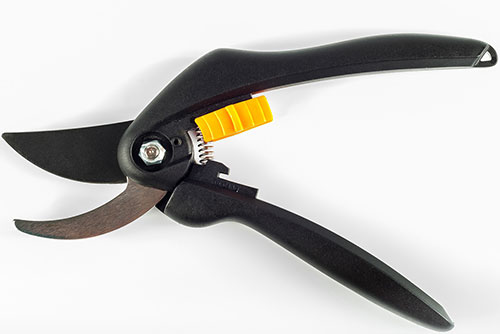
Pruning shears
Lopping Shears – These shears should be used for tree branches up to 1½ inches in diameter. Use lopping shears with lightweight and extendable handles for easier use and reaching higher branches.
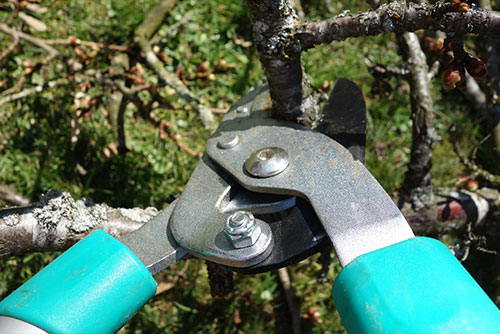
Lopping shears
Pruning Saw – A pruning saw should be used for tree branches more than 1½ inches in diameter. The coarse teeth cut on the pull stroke, making pruning easier and safer.
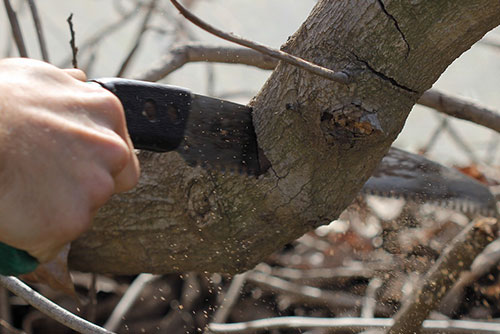
Pruning saw
Chainsaw – Use a chainsaw when removing branches or limbs over 4 inches in diameter. Clean and fast cuts can be made more efficiently with a chainsaw for branches of this size or larger.
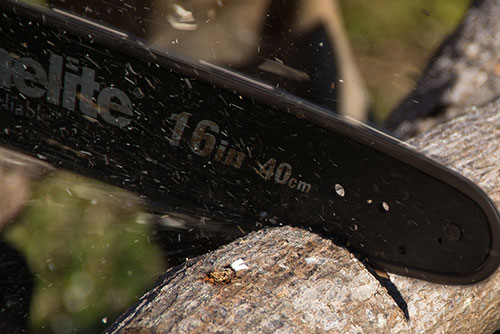
Chainsaw
Tip: If you are unsure of how to use a chainsaw, call a professional tree service to prune these larger limbs.
Pole Pruners – Pole pruners are used for branches more than 1 inch thick and out of reach.
Hedge Shears – Hedge shears are used for shaping and cutting back new growth on shrubs.
Before using any new equipment for the first time, please read the manual to familiarize yourself with its instructions, safety features, and warnings.
Note: As branches or limbs increase in diameter and length, the heavier they become. For your safety, when more massive branches out of your reach need to be removed, consider hiring a professional tree service to get the job done for you.
The following are general guidelines to help you correctly prune your deciduous trees and shrubs:
• Limit normal pruning activities to late fall through early spring. This is the time when most trees are in a state of dormancy and are less affected by pruning activities.
• Diseased, dead, and broken branches should be pruned from your trees and shrubs whenever they are detected.
• When two limbs are crossed or making contact, remove one of them at the base.
• Remove downward-growing branches.
• Remove any limbs that are larger in diameter than the trunk.
• Make pruning cuts for smaller branches just above the branch collar. For larger or heavier branches, use a 3-cut method with the first cut 8 to 12 inches out on the branch from the underside, one- fourth of the way up (this prevents the bark from tearing when the branch falls). The second cut further out on the branch, from the top, to remove the bulk of the branch. The final cut should happen just above the branch collar (without wounding it).
• Remove any suckers growing from the lower portion of the trunk or the roots.
• If more than 25% of your tree’s canopy will be lost due to pruning, have the tree evaluated by a professional tree service before pruning activities begin.
Tip: If you are pruning your trees and shrubs to encourage vegetation growth, make a cut at a 45-degree angle with the lower end even with the bud or just above a junction on a branch. You can use cuts like these to shape a tree or shrub.
Note: Avoid topping trees (shearing or cutting the canopy horizontally to shorten the tree). This type of pruning invites disease and infestation while significantly endangering the health of the tree. To lower the height of your tree, hire a professional tree service to ensure this is done with minimal impact on the tree.
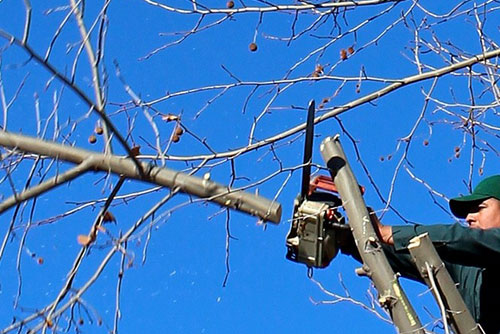
Tree topping
Pruning Evergreen Trees And Shrubs
Like deciduous trees and shrubs, the best time to prune evergreen trees is in the winter months. For evergreen shrubs, like juniper and yew, prune in late March or early April (before new growth emerges). The following will help you correctly prune your evergreen trees and shrubs:
• Pruning broadleaf evergreens like camellia and boxwood follows the same general guidelines for cutting as for deciduous trees and shrubs.
• For flowering broad-leaved evergreens, prune after the tree blooms for those that flower on the previous season’s growth. For those that flower on the new season’s growth, prune before spring growth begins.
• For conifers like spruce and pine, prune during the first two to three years to form their basic shape. Any subsequent pruning should be done by a professional tree service.
• Species like arborvitae, yew, and hemlock can be sheared annually when used as hedges or privacy screens.
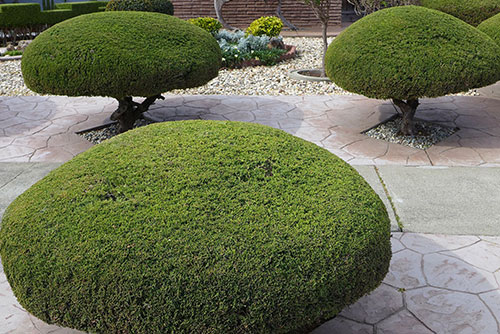
Shaped evergreens
Note: Over pruning conifers can lead to structural and health problems, allowing infestation and disease to fully compromise their health and kill them.
Common Pruning Mistakes
Try to avoid committing the following mistakes when pruning your trees and shrubs (you are probably guilty of number 3):
Injured Branch Collar – When cutting limbs or branches off of a tree, make your final cut as close to the branch collar as possible without injuring the branch collar.
Torn Bark – Don’t forget to make the undercut when removing larger branches. This helps to avoid tearing bark from the trunk when the limb falls.
Spreading Viruses – When moving from tree to tree, or shrub to shrub, it is essential to sanitize your pruning equipment to prevent spreading harmful pathogens from one to the next.
Removing Too Much – As previously stated, when you need to remove more than 25% of a tree’s canopy, call a professional tree service to evaluate the tree’s circumstances.
Topping – When a tree grows taller than expected, many are inclined to shear off the top of the crown (topping). This act weakens the branch structure and leaves the specimen with potential disease and infestation problems.
Timing – Most pruning activities are performed in the late fall to early spring. This avoids stressing the tree’s health. There are species like some maples, birch, and walnut trees that get some benefit from early summer pruning. After severe weather during any season, you may need to break out the pruning shears.
When severe weather events damage your trees and shrubs, all pruning guidelines are suspended. These trees need to have broken branches and limbs removed as quickly as possible to prevent disease and insect infestation problems.
For trees with extensive damage to limbs and bark, a professional tree service should be hired to evaluate the tree and recommend a course of action.
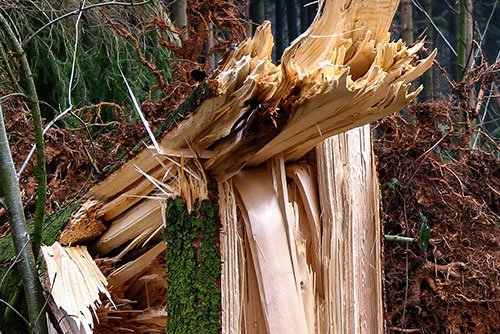
Storm damaged tree
Tree And Shrub Pruning
In this article, you discovered how to prune trees and shrubs, the benefits of pruning, and common mistakes to avoid.
By seasonally pruning your trees and shrubs properly, you are encouraging healthy growth, removing dead or damaged wood, and preventing illness or infestations.
When you allow your trees and shrubs to grow unchecked, you are inviting disease, infestation, poor health, and death to consume your tree or shrub.
Sources:
ag.ndsu.edu/publications/lawns-gardens-trees/basic-guidelines-for-pruning-trees-and-shrubs
extension.umn.edu/planting-and-growing-guides/pruning-trees-and-shrubs
newhanover.ces.ncsu.edu/2017/02/most-common-pruning-mistakes/
hortnews.extension.iastate.edu/2015/03-13/pruning.html